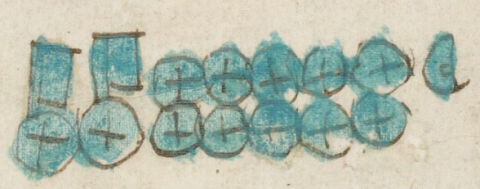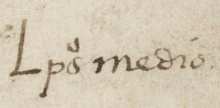50.5 pesos (TV1r)
This simplex glyph for the noun "peso" (a Spanish coin) is combined with the notation for fifty and a half (50.5). The numbering involves two flags each symbolizing twenty (tecpantli), then ten ones, and a half peso. The flags are the standard rectangle on a short pole, in this case flying to the viewer's right. The coins have a cross (+) on them. Everything is painted a turquoise blue.
Stephanie Wood
The gloss for this notation for large quantity of pesos partly involves a Roman numeral, "L," for 50. The peso was worth eight tomines or eight reales. Given low rates of pay, these smaller values were very common in Nahua communities. These lesser coins might be marked with a number of dots (for example, two dots would mean the notation represents two tomines or the value of a quarter of a peso). A half peso, if not actually cut in half as we see here, might have the number 4 written on it, sometimes tipped sideways (as shown below).
It is a challenge to differentiate between the panitl (or pamitl), pantli, and tecpantli, for they look very much alike most of the time. For now, when the banner has an association with a number, we are using pantli or tecpantli, depending upon how it is glossed, and when it is a phonetic locative for a place name, we are using panitl. Apparently panitl was more common in "Mexico, the Tepanec heartland, and perhaps Colhuacan and Chalco," and pamitl in "northern and eastern flanks of the Valley of Mexico" [see: Jorge Klor de Alva, in The Work of Bernardino de Sahagún: Pioneer Ethnographer of Sixteenth-century Aztec Mexico (Albany, NY: Institute for Mesoamerican Studies, the University at Albany, State University of New York, 1988), 323]. As glyphs come in to this collection from regions where pamitl is more common, we will abide by that orthography.
Stephanie Wood
L pos medio
50 pesos [y] medio
Stephanie Wood
1574
Jeff Haskett-Wood
monedas, dinero, pesos

peso, a unit of money, https://nahuatl.wired-humanities.org/content/peso
tecpan(tli), a flag representing the number twenty, https://nahuatl.wired-humanities.org/content/tecpantli
cincuenta y medio pesos
Stephanie Wood
El Libro de los Tributos de San Pablo Teocaltitlan, also known as the Codex Valeriano and Manuscrit Mexicain 376, is hosted by the Bibliothèque nationale de France, published on line in the digital resource, Gallica, https://gallica.bnf.fr/ark:/12148/btv1b8455947h/f9.item.r=Libro%20de%20t...
The non-commercial reuse of images from the Bibliothèque nationale de France is free as long as the user is in compliance with the legislation in force and provides the citation: “Source gallica.bnf.fr / Bibliothèque nationale de France” or “Source gallica.bnf.fr / BnF.” We would also appreciate a citation to the Visual Lexicon of Aztec Hieroglyphs, https://aztecglyphs.wired-humanities.org/.




